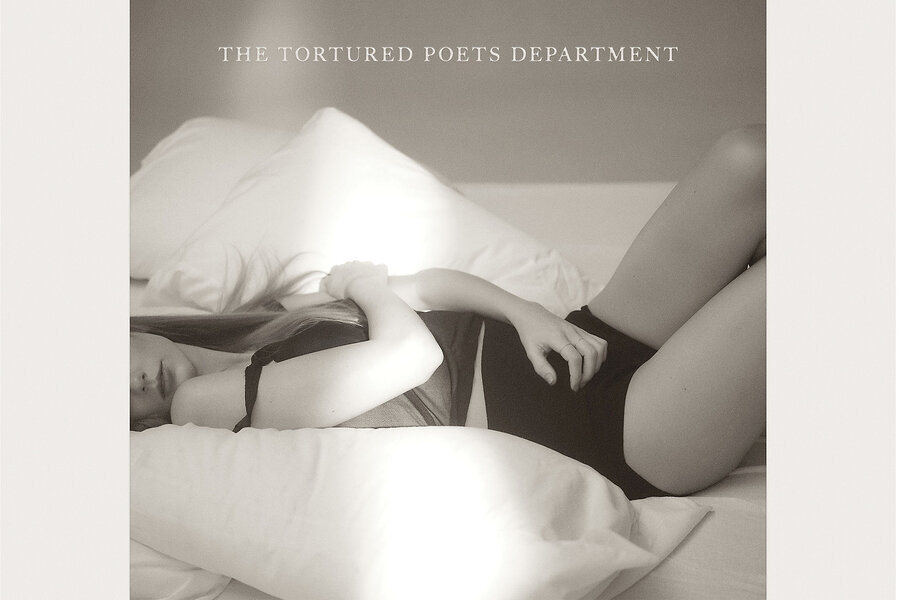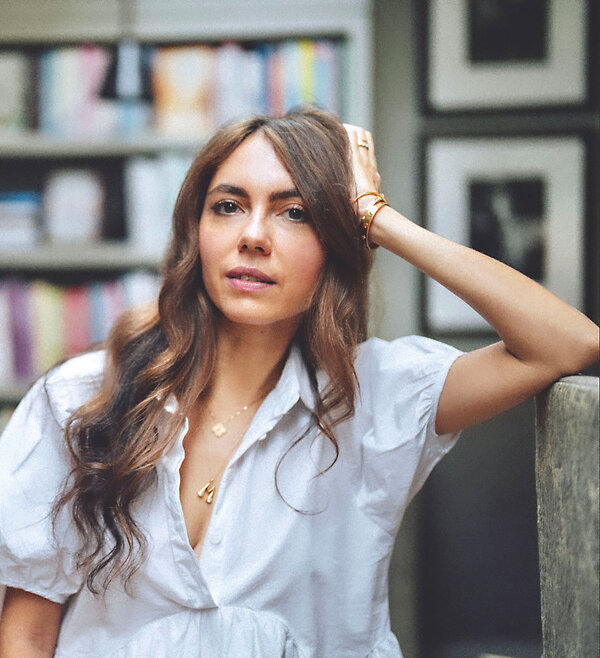OK, she’s worth $1 billion, but can Taylor Swift write poetry? We ask the experts.
Loading...
Taylor Swift occupies a position in popular culture that makes Beatlemania seem like a passing fad. Her every move is scrutinized.
The April 19 release of her new album has been shrouded in a blackout. No advance singles. Zero interviews. But Ms. Swift’s 11th LP does appear to follow a poetic theme. The album’s tagline is “All’s fair in love and poetry.” It’s being released during National Poetry Month.
Why We Wrote This
A story focused onDo poems and lyrics serve the same function in art? Or are they entirely different mediums? We asked poets (and Swift fans) for their analysis of Taylor Swift’s wordsmithing.
Consequently, “The Tortured Poets Department” is heating up a debate that’s been simmering since before Bob Dylan won the Nobel Prize for literature in 2016: Can lyrics qualify as poetry?
Historically, poems were often performed aloud with musical accompaniment. The etymology of “lyric poetry” is the Greek word lyrikos, which means “singing to the lyre.”
“There are people out there who would argue that a pop star can’t be a poet,” says Elly McCausland, who teaches the “Literature (Taylor’s Version)” course at Ghent University in Belgium. “She’s deliberately pushing back against that and also asking us to examine our own attitudes. What is poetry? What can poetry be?”
Taylor Swift almost eclipsed the eclipse.
During the moon’s astronomical photobomb of the sun on April 8, the songwriter posted an update to Instagram. Her video reel featured a typewriter hammering out the words, “Crowd goes wild at her fingertips. Half moonshine, full eclipse.” The first tease from Ms. Swift’s new album, “The Tortured Poets Department,” wasn’t a snippet of music. It was a lyric.
The April 19 release has been shrouded in its own form of blackout. No advance singles. Zero interviews. The result? The album is as mysterious as the identity of the boy who inspired Ms. Swift’s 2008 song “Love Story.” But Ms. Swift’s 11th LP does appear to follow a poetic theme. The album’s tagline is “All’s fair in love and poetry.” It’s being released during National Poetry Month.
Why We Wrote This
A story focused onDo poems and lyrics serve the same function in art? Or are they entirely different mediums? We asked poets (and Swift fans) for their analysis of Taylor Swift’s wordsmithing.
Ms. Swift occupies a position in popular culture that makes Beatlemania seem like a passing fad. Her every move is scrutinized.
Consequently, her album is raising the question of whether lyrics qualify as poetry. “The Tortured Poets Department” is heating up a debate that’s been simmering since Bob Dylan won the Nobel Prize for literature in 2016.
“There are people out there who would argue that a pop star can’t be a poet,” says Elly McCausland, who teaches the “Literature (Taylor’s Version)” course at Ghent University in Belgium. “She’s deliberately pushing back against that and also asking us to examine our own attitudes. What is poetry? What can poetry be? Can a woman be a chairman of a tortured poets department?”
Before Ms. Swift was a songwriter, she was a poet. In fourth grade, she won a national poetry contest for her composition “Monster in My Closet.” Nowadays, she’s writing about herself as the “monster on the hill” in the hit single “Anti-Hero.” That song features couplets that showcase her wordplay: “Midnights become my afternoons / When my depression works the graveyard shift / All the people I’ve ghosted stand there in the room.”
But is it poetry?
Historically, poems were often performed aloud with musical accompaniment. The etymology of “lyric poetry” is the Greek word lyrikos, which means “singing to the lyre.”
“Gradually, they’ve drifted apart. And now I think with artists like Taylor Swift, we see them coming back together,” says Dr. McCausland, who teaches students how the songwriter fits into a genealogy of literature dating back to the 10th century.
By contrast, Publishers Weekly poetry reviews editor Maya C. Popa says although lyrics can be poetic and poems can be musical, they are different mediums.
“On the page, as a poet, without the music, you’re putting a different kind of pressure on the language to convey musicality, to convey depth, and to lean into mystery,” says Ms. Popa, a Swiftie whose latest book is titled “Wound Is the Origin of Wonder.” “[T.S.] Eliot said genuine poetry communicates before it is understood. I don’t think that’s true, necessarily, for song lyrics.”
She adds that debates over whether lyrics qualify as poetry “reveal the frivolities of the human ego … and our impulse to create hierarchies in all things.”
Ms. Swift’s connections to poetry predate her latest album. She has cited Emily Dickinson – who is her sixth cousin, three times removed – as an influence. The liner notes for “Red” name-check Nobel Prize winner Pablo Neruda. In 2017, the pop star published two poems in a mock-up magazine bundled with her “Reputation” album. But it was the 2020 album, “Folklore,” on which Ms. Swift appeared to consciously court comparison to classic bards. Its artwork features a quill-like font and photos of the singer wandering through woods in cottagecore outfits. The solitary writer communing with nature. Not a single paparazzo in sight.
“Take me to the Lakes, where all the poets went to die,” she sings on the album closer “the lakes.” Lord Byron and his fellow Romantics were rock stars of the 19th century. By contrast, female geniuses faced social censure. Emily Dickinson was deemed a “weird spinster,” says Ms. Popa. In her song, Ms. Swift asks, “Tell me what are my Wordsworth.” It raises the question: If the author of “Because I could not stop for Death / He kindly stopped for me” were alive today, would she be worth $1 billion?
“[Swift’s] really interested in thinking about, ‘Why is what I’m doing different to what Wordsworth [was] doing? And how is it the same? And what is the tension between those things?’” says Clio Doyle, author of the upcoming book, “Dear Reader: Taylor Swift and the Idea of English Literature.”
Dr. Doyle cites the 10-minute version of “All Too Well” as an example of Ms. Swift’s literary wordsmithery. The song chronicles a brief, clandestine relationship. “You kept me like a secret / But I kept you like an oath,” Ms. Swift sings.
“The ways in which she’s explaining why it was great and why it shouldn’t have ended, and why it’s such a tragedy that the guy ended it, are also kind of ways in which she’s revealing that maybe it was never great at all,” says Dr. Doyle, who teaches a course on Taylor Swift and Literature at Queen Mary University of London.
In her songs, Ms. Swift has checked into the heartbreak hotel so many times that she really should sign up for the rewards program. So it’s not entirely surprising that her social media posts are signed, “Chairman of the Tortured Poets Department.” But some of the new album’s song titles – “But Daddy I Love Him” and “I Can Fix Him (No Really I Can)” – suggest that Ms. Swift isn’t taking herself too seriously.
“She exemplifies that side of poetry – the lyricism, but also the approachability – which is where I would say that poetry is going in general,” says poet Kara Lewis, a Best of the Net nominee and an editor for On the Left Bank, a journal of socialist art and poetry.
Poetry’s new stars are so-called Instapoets, explains Ms. Lewis, who once spent 20 hours creating a light-up sign to take to Ms. Swift’s “1989” tour. Platforms such as Instagram, TikTok, Tumblr, and Substack offer an alternative to “gatekeep-y” institutions. The Instapoetry genre tends to be bite-size, with subjects ranging from social justice issues to diaristic reflections on relationships. Much like Ms. Swift’s lyrics.
“There are poems for every day and every moment of our lives because poets make the world more sensible to us, through attention and reflection,” said Ricardo Alberto Maldonado, president and executive director of the Academy of American Poets in a quote provided via email. “I’m jazzed to hear what Swift makes of poetry’s calling in her album. ... We hope she brings millions of readers across the globe to poetry.”
At Newton Free Library in Massachusetts, a “Tortured Poets Department” display features books such as “Postcolonial Love Poem” by Natalie Diaz and “Blushing” by Paul B. Janeczko. Nationwide, numerous libraries have scheduled listening parties for the new album that will also feature blackout poetry.
“I’m very pleased that people gravitate to her lyrics,” says Ms. Popa, whose gateway to poetry was listening to Rufus Wainwright’s literary songs. “I hope it inspires them to write their own lyrics, to write their own poems, and then to go in search of poets who have dedicated themselves to poetry. I think that’s the best possible scenario.”











